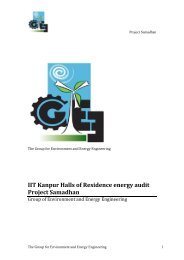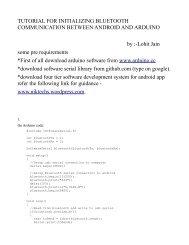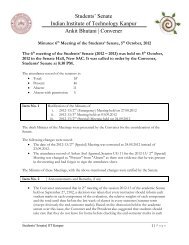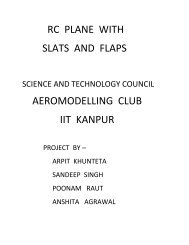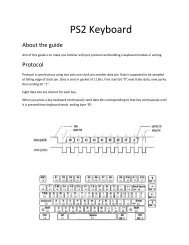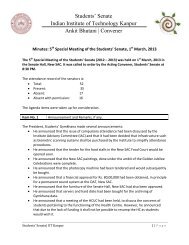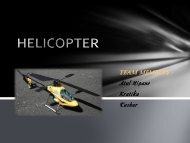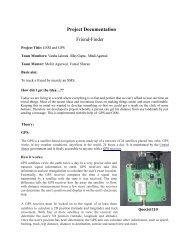Boomerang Lecture
Boomerang Lecture
Boomerang Lecture
You also want an ePaper? Increase the reach of your titles
YUMPU automatically turns print PDFs into web optimized ePapers that Google loves.
Outline<br />
• What is a boomerang?<br />
• History of boomerangs<br />
• Features and types of a boomerang<br />
• Basic aerodynamics of a boomerang<br />
• Why does a boomerang work?<br />
• Fabrication of a boomerang<br />
• Throwing techniques
What is a boomerang?<br />
• Curved piece of wood etc.<br />
• Heavier than air flying object<br />
• Flies and Returns when<br />
thrown properly.<br />
• Smallest - 10cm tip to tip<br />
• Largest – 2m tip to tip
History of boomerangs<br />
• Believed to be the first ‘heavier than air’ flying<br />
objects<br />
• 30,000 years old boomerang found<br />
• Prominently used by Australian aborigines but<br />
evidence of even earlier presence was found<br />
• Were used as hunting sticks (non-return type<br />
called kylies), which would not return.<br />
• Developments over the year have now given us<br />
highly efficient boomerangs
Features and types of a boomerang<br />
• Wide variety of shapes<br />
• Different profiles for right and left handed<br />
throws ( Video 1)
Basic aerodynamics<br />
LIFT - Air passing over the curved top of a boomerang’s airfoil — at<br />
the leading edge of the wing — is forced to go faster than air passing<br />
over the relatively flat underside. As described by Bernoulli’s<br />
principle, this generates less pressure above the wing, creating upward<br />
lift. ( 2,3,4,5)<br />
SPIN - The rate of a boomerang’s spin is determined by the length of<br />
the wings, the angle at which they’re joined, the distribution of<br />
material and the amount of force applied by the thrower. Like a<br />
gyroscope, a boomerang has greater stability the faster it spins.
Lift
lift
PRECESSION<br />
• PRECESSION - A boomerang is thrown at a slight outward tilt from<br />
vertical. The top wing rotates with the object’s forward motion, so it<br />
moves faster than the bottom wing, generating more lift. Because the<br />
boomerang is spinning, the lift exerts a steady force that is felt 90<br />
degrees later, at the point in each rotation farthest from the thrower.<br />
This force nudges the wing laterally and the spin axis shifts. The<br />
boomerang turns — eventually curving all the way back to its starting<br />
point.
PRECESSION<br />
• The device, once spinning, tends to resist changes to its orientation. If<br />
external force F1 is applied to some point which is at radius r from<br />
rotation ti axis of gyroscope, the spinning i device begins to rotate. t The<br />
motion "seems to be strange" as it does not follow the applied force<br />
direction, but moves in a perpendicular one. This rotation of spinning<br />
plane is called precession.<br />
The simplest explanation of the phenomenon is shown below.<br />
• The gyroscopic precession is fundamental phenomenon which explains<br />
why boomerang returns.<br />
http://www.boomerangs.com/aerodynamics.html
“No Hands” Bicycle Turn
Why does a boomerang work?<br />
Ref. Popular Mechanics
Why does a boomerang work?
Fabrication of a boomerang<br />
• Fabrication is done using any hardwood<br />
• Birch wood is preferred<br />
• The aerodynamic profile is given using abrasives<br />
• Some boomerangs also employ turbulators to keep<br />
the flow attached, and generate more lift
Fabrication of a boomerang<br />
• Roughly 30 in. long, this 19th century rang from Western<br />
Australia is made from mulga — a wood so dense “it sinks<br />
like a stone in water,” It weighs nearly 2 pounds, so, “You<br />
definitely want to stay out of the way when it comes back.”<br />
The unknown maker carved grooves into the top and<br />
bottom, shaving off a tiny bit of weight (crucial in a sport<br />
where the mass of a paper clip can clinch a record throw).<br />
The grooves also form hollows that<br />
— like the dimples on<br />
a golfball — create a blunt airfoil, which increases lift.<br />
Ref. Popular Mechanics
Throwing technique<br />
• More spin to be given than force<br />
• Launch at a slight angle to the vertical<br />
• Wind has to be accounted for- right handed<br />
boomerangs are launched to the right of the<br />
wind<br />
• Launch has to be perfected by practice
Workshop<br />
• All the above points will be demonstrated in the<br />
workshop.<br />
• You will be taught everything from scratch
Summary<br />
• <strong>Boomerang</strong> is a flying object that comes back<br />
when thrown properly<br />
• Supposed to be developed by Aboringes of<br />
Australia.<br />
• <strong>Boomerang</strong> of variety of shapes and sizes are<br />
found.<br />
• Lift is perpendicular force experienced due to<br />
relative velocity.
Summary<br />
• Lift experienced by boomerang help it to fly.<br />
• Force applied at a point on spinning wheel is felt<br />
90deg. Off. ( No hand Bicycle turn).<br />
• The gyroscopic precession phenomenon make<br />
boomerang return.<br />
• <strong>Boomerang</strong> should be thrown with some angle<br />
from vertical and good spin.



